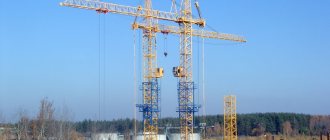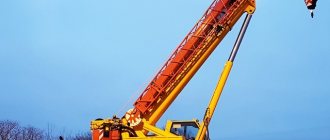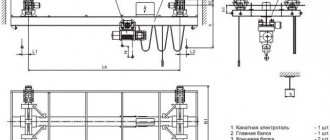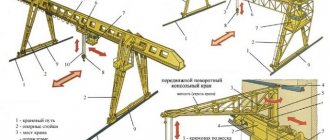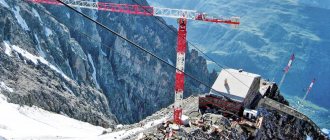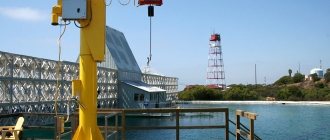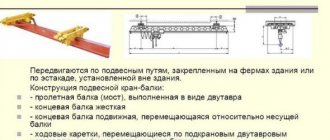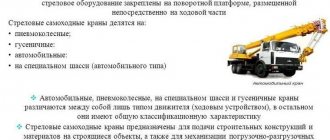- Main elements of portal cranes
- Types of portal cranes by application
- Types of gantry crane booms
- Types of portal designs
- Number of support legs
- Type of undercarriage
- Spare parts for portal cranes
A portal crane is a lifting device with a rotating part. Movement in the horizontal plane is carried out on rails or pneumatic wheels. These devices are used for loading and unloading operations in the port, construction of berths, and dams.
Portal cranes differ in the design of the rotating part and the type of boom. The main components of portal cranes are:
- Column
- portal
Due to the use of portal cranes in installation and assembly work, ship construction, and large hydraulic engineering works, the requirements for them have recently increased sharply. Modern models support a lifting capacity of up to 400 tons with a boom reach of up to 50 m.
Gantry cranes
This is lifting equipment with a rotating part installed on a mobile metal structure that rides on rails and is capable of passing railway cars and other vehicles under it. Portal cranes have found wide application in the construction of power buildings, locks, dams, hydroelectric power stations and other important facilities. They are actively used in ship docks and at border warehouses, when working with bulk, critical piece, bulk cargo.
Portal crane device
In general, it consists of the following mechanisms:
A leg is an element with a trolley at the bottom (idle or motor) that provides movement along the crane track. The number of legs varies depending on the model and can be either 3 or 4 (classic version), or 8 or even 16. All carts are equipped with an anti-theft grip, each has an individual drive (if they are motorized), and the outer ones are necessarily buffered .
The head is a platform for connecting the legs, square or round. In addition to the final formation of the portal, with a travel distance of 10.5 m (standard for 2 tracks) or some other, it is also a connection point for electrical equipment - all bogie drives. Plus, the head is also a supporting element that receives loads from the rotating device.
Current lead is a cable, flexible or on a drum, which is attached to one of the legs or to the connecting crossbar, and is wound up/unwound when the crane moves. Also, current can be supplied using a trolley, but this is a rather expensive option, used only when it is inappropriate to lay a cable at a work site due to the high probability of its breakage or damage.
Rotating device - a column or circle on rollers in contact with the head. Supports and centers the drive that ensures the rotation of the gantry crane. Transfers loads and vertical pressure to the head.
Boom device - with a gripping mechanism that performs vertical and horizontal (if the reach can be changed) movement of cargo. Equipped with a system of movable counterweights, thanks to which balance is achieved in relation to the swing axis during operation.
Classification of portal cranes
By purpose they are distinguished:
- Transshipment - the most common type, used in ports and warehouses. They are equipped with hooks, magnetic washers or grabs - for moving piece, metal or bulk bodies. At all flights, their carrying capacity remains constant - from 1.5 to 30 tons.
- Mounting - usually installed at shipbuilding and ship repair shipyards, they are distinguished by high leg heights. Used when working with piece cargo of special responsibility, they can be equipped with two hooks and anti-tip grips. They have a low operating speed and a variable, depending on the reach, load capacity - from 12.5 to 160 tons.
- Construction – used where it is necessary to mechanize high-performance work over a long period of time. They are used, for example, to lay concrete during the construction of dams. Portal-type construction cranes are usually equipped with hooks and are characterized by high speed of moving loads weighing 10-20 tons (usually) horizontally and vertically over a distance of 50-70 m.
According to the type (pattern) of the arrow there are:
- straight – the offset remains unchanged;
- articulated - with a flexible or rigid guy, a straight or profiled trunk, leveling blocks or pulleys - all this is aimed at changing the reach;
According to the design of the portal, cranes are classified into:
- lattice – each leg is a separate structure;
- frame - the legs are connected in pairs and thus attached to the crossbar through the head;
- frame-tower - similar to the previous ones, but only reach the top;
- frame-braced - each leg is hinged to the crossbar.
Based on the number of supports (legs) there are:
- three-
- four-
- multi-support.
According to the number of connections between the legs and the upper crossbar, portal cranes:
- two-
- four-
- multi-post.
In this case, the nature of the connection of the legs with the upper crossbar can be:
- rigid - legs do not move;
- articulated - the supports can change their position (after the head).
According to the running device, portal cranes are:
- on rails - they move exclusively along the paved path;
- pneumatic wheels are more mobile; they can even be turned on the spot.
o-cranes.ru
Design features of the manual gantry crane KR2
The mobile rail lift KR2 consists of a powerful metal frame and a lifting mechanism. A carriage, which is a lifting mechanism with a chain and gearbox, moves along the top beam of the frame located above the rails. At the end of the chain there is a rail grip, the so-called “pincers”, which catch the rail and hold it firmly. With the help of a gearbox, the rail is raised to the required height, a transverse movement handle is installed inside the frame to move the rail, and then the rail is transported to the required distance.
The main features of the Kuban traveling gantry crane are a remote gearbox from the work area (lifting) and a braking device that reliably fixes the movement of the carriage and a retractable foot that allows work to be done off-track. All this helps eliminate accidents and dropped loads. It is also important that in the production of gantry traveling cranes for changing rails of the KR series, we use electrical insulation of the wheels from the crane frame, this eliminates any possibility of interference with the automatic blocking signals of the railway track.
A portal crane is... What is a portal crane?
A portal crane is a full-rotating jib crane, the rotating part of which is installed on a portal that moves along rails laid on the ground or overpass.
Description
There are reloading (grab and hook) and installation (construction and shipbuilding, etc.) cranes. The lifting capacity of cranes produced in the USSR was 80 tons, in other countries - up to 300 tons. The wind load is determined according to GOST 1451-77 and taken into account when choosing engines (Wind load of the crane operating condition). The rules for the technical operation of reloading machines at seaports prohibit the operation of shore cranes at wind speeds of 15 m/s or more.
Device
Portals
Depending on the number of railway tracks to be covered, portals are single-, double- and triple-track. The internal contour of the portal must correspond to the approach dimensions of buildings in accordance with GOST 9238-73. The portals differ:
By type of connection of supports to the upper crossbar:
- Articulated.
- Hard.
According to the number of connections of supports to the upper crossbar:
- Two-post.
- Four-post.
According to the number of connections to the chassis:
- Three-legged.
- four-legged.
According to the method of formation of the structure:
- Lattice.
- Frame.
- Frame-tower.
- Frame-braced.
The design of the portal is influenced by the type of slewing bearing device (abbr. OPU). The turning mechanisms have a conventional design with a worm or gear reducer, a bevel or multi-plate torque limit clutch and an open gear or lantern drive.
Mechanisms
Portal cranes have mechanisms for lifting, changing reach, turning and moving (moving is an installation movement, the rest are working ones).
Travel devices
The movement mechanisms consist of driven and non-driven trolleys, united by a system of balancers. The length of the balancer arms is selected taking into account the equal load on all wheels. With a wheel diameter of 560–710 mm (load 250–400 kN), 12 or more wheels are placed under the support. The trolleys are equipped with anti-theft grips.
Application
The working parts of loading cranes are:
Typically these cranes are equipped with an additional hook cage.
Assembly
Assembly cranes are designed for work with critical piece cargo. On assembly cranes, for their effective use, a change in the permissible load capacity is provided depending on the reach.
Gantry docks
Cranes with a hopper on the portal. Rotation is eliminated from the crane's operating cycle, thereby increasing productivity. The movement of the grab from the hold to the bunker and back is ensured only by the mechanisms of lifting and changing the reach. From the grab, the cargo is poured into a bunker and delivered to the warehouse by conveyors, one or two of which are installed on a crane. The dimensions of the bunker in plan, taking into account the swinging of the grab on the ropes, are significant. To reduce swaying, the length of the suspension should be as short as possible. When the crane moves along the vessel, the hopper should not protrude towards the shore rail beyond the overall dimensions of the portal. When unloading cargo from a ship, the bunker is installed horizontally, and when the crane moves along the pier, it is installed vertically; in this case, the bunker does not touch the superstructure of the vessel.
Cranes with hopper on portal
Cranes with a hopper on the portal are used for unloading bulk cargo with a stable cargo flow.
Notes
- ↑ 1 2 3 4 5 6 7 8 9 10 11 12 13 14 15 16 17 18 19 20 21 22 P. Z. Petukhov, G. P. Ksyunin, L. G. Serlin - Special cranes - M: Mechanical Engineering, 1985, 248s.
dic.academic.ru
Boom system and lifting mechanism
The boom system consists of:
- arrows;
- trunk;
- rigid guy and rocker arm, hingedly connected to each other;
- a counterweight that balances the boom system and is attached to the beam.
The rack and pinion mechanism changes the boom reach. The movement of the outreach in cranes of a similar boom system design ensures almost horizontal movement of the load, which does not require additional adjustments of its position in space.
The mechanism for changing the boom reach is rack and pinion type.
The mechanism is driven by two engines of the same 14 kW power, one of which acts as a drive, and the second as a brake. The motors are connected to the high-speed gearbox shaft by bush-pin couplings, one half of which is made in the form of a brake pulley.
The gear ratio is 63. The low-speed gearbox shaft is connected to a pinion shaft that meshes with the rack.
The mechanism is braked by two double-block brakes with electro-hydraulic pushers. Smooth braking is achieved due to the action of a DC braking motor and a mechanism creating dynamic braking, which leads to a gradual decrease in the rate of change of the boom extension.
The boom, trunk, guy and rocker are made in the form of box-shaped steel structures. Equipped with stairs and platforms for servicing mechanisms and product components.
The mechanism is equipped with three spindle limit switches. The main one is designed to turn off the engine at overhangs of 8 and 32 meters. The preliminary one is activated at overhangs of 9 and 31 meters, and is used to turn on the braking motor, which reduces the speed of change of overhang.
The third switch is designed to work with loads of 20 tons, and operates at reach lengths of 10 and 16 meters. The machine room and control cabin are mounted on the crane column. The machine room has a removable roof for easy installation and dismantling of equipment.
Classification of overhead cranes
In accordance with GOST requirements, all models on the market are divided into general-purpose and narrow-purpose devices. Specialized mechanisms are distinguished by the fact that they include narrow-directional grippers. For example, when working with scrap metal, magnetic overhead cranes are used, and when working with bulk materials, grabs are used. General industrial models are equipped with a hook with an automatic latch, which allows them to be used for moving loads on rafters.
GOST 27584-88 Electric overhead and gantry cranes. General technical conditions
1 file 614.74 KB
Certain types of overhead cranes are developed for operation in certain industries, taking into account the specifics of the tasks and working conditions. Such equipment is produced, for example, for metallurgical enterprises. They are distinguished by their ability to withstand long-term operation under conditions of exposure to aggressive environments and high temperatures, and are equipped with special grips (forging, foundry, for working with ingots).
There are also single-girder and double-girder overhead cranes. If the bridge consists of one beam, the lifting equipment is relatively light in weight. But this negatively affects their load capacity: it will not exceed 10 tons. At the same time, it is possible to equip it with an additional cantilever trolley, which will expand the scope of application of the equipment.
Double-beam models allow the use of not only a standard cargo trolley, but also additional attachments. Due to this, the scope of use of equipment increases, control capabilities expand through the use of remote controls. These are powerful overhead cranes that are actively used at production enterprises in various industries.
By design
Depending on the method of installation of metal structures on the crane runway, suspended and supporting modifications of the equipment are distinguished. In the first case, the fastening is performed on the lower, and in the second case, on the upper horizontal chord of the span beam.
An important advantage of hanging mechanisms is the relatively low cost and ease of installation work. But the load capacity of such mechanisms does not exceed 8 tons. The structures are characterized by a low height, which makes it possible to increase the working area in comparison with support analogues that have greater productivity (up to 500 tons).
By way of movement
Standard bridge models move along parallel tracks during work. But the design of overhead cranes allows them to be used in modifications that take into account the peculiarities of the technological process and the nature of the placement of production equipment. To solve specialized problems, it is possible to install lifting equipment with the following principles of movement.
- Radial. The lifting mechanism on the beam will be able to rotate around the platform, which is rigidly fixed in the center of the workshop, along a ring rail.
- Rotary. Unlike the previous option, work can be carried out at any point; restrictions on movement are associated only with the length of the laid crane tracks.
- Chordoval with a smaller service area compared to radial. Due to the design features, the radius of rotation will remain unchanged.
- Circular with the movement of mechanisms on rails of different diameters. The design in this version is somewhat more complicated due to the need to use running wheels that differ in size to avoid slipping.
By load capacity
The lifting capacity of overhead cranes is one of the main characteristics of equipment. The most widely used models are those in which this parameter is 1-50 tons. In most cases, this is sufficient for industrial use. To perform narrow-profile tasks, equipment with a lifting capacity of up to 500 tons is used (for example, for installing a hydroelectric power station turbine).
By drive type
Bridge models are available with manual and electric drive. In the first case, worm-type hoists are used as the main working mechanism for movement. This is the best option if you need to regularly work with small loads during assembly or repair work at machine-building enterprises.
An electric drive for an overhead crane is used more often, as it allows you to successfully work with high-tonnage loads without physical effort on the part of the operator. To move the structures, up to 4 electric motors are used (depending on performance requirements). To transmit rotation to the wheels, only the gearbox or its combination with the transmission is used.
Scope of application of the manual gantry crane KR2
The KR2 gantry crane is designed for lifting and moving rails along a railway track with a width of 1520 mm during routine maintenance, track repair and rail replacement. It is designed for changing and transporting rails of types P50, P65, P75. Typically, during track work, the gantry crane is serviced by two workers.
With a rail length of up to 12.5 meters, as a rule, one gantry crane is used; if it is necessary to replace a rail longer than 12.5 meters, it is recommended to use 2 manual cranes. Practice shows that the working lifting set consists of two KR2 cranes, which provides an efficient and inexpensive way to carry out track work without the involvement of heavy track equipment. Thus, the use of KR2 portal cranes allows railway workers to significantly reduce the cost of local track repairs.
A manual gantry crane is delivered to the place where track repair work is being carried out by road vehicles, railcars, railcars or track vehicles. In the place of local work on routine track maintenance, cranes can easily move along the rails. When independently transporting a traveling crane of the KR series, it is necessary to be accompanied by signalmen.
Petal steps
The engine room, electronics and automation, the crane operator’s cabin - all this is located at the height of a 12-13-story building. The way there is exclusively on foot. First, you need to climb along steep, ship-like ladders to the upper platform of the portal, and then climb the spiral staircase inside the column on which the crane stands. While you are walking up this staircase, you don’t look up - it’s scary to think how many more steps are ahead. When you go down, it seems that the steps below turn into the petals of a rotating flower. This optical illusion makes your head spin. Ugh! At the top, inside the engine room platform, is a large round room where the crane's slewing mechanisms are installed. The main and auxiliary lift winches are located on the floor above. The ends of the cables disappear into the cracks in the ceiling. Above the engine room, on a rack, there is a rack-and-pinion mechanism for changing the boom reach.
The resemblance to birds - a crane or a heron - is given to portal cranes by an articulated boom system. Another element is attached to the main boom on a hinge - it is called the “beak”, “jib”, and sometimes “trunk”. This system was invented in the late 1930s in Germany. When the main boom changes reach (that is, rises or falls), the load suspended from it also inevitably changes height. In an articulated system, the “trunk” performs a compensating movement, holding the load at a given height. This does not require the operation of a lifting winch, which means no extra energy is wasted. Both during installation and during reloading work, keeping the load at the same level is an important safety factor.
The crane operator's cabin is located at the height of a 12-13-story building, and the path there is not easy: first climb up steep ladders, then take many steps along a spiral staircase.
And finally, the cabin from which all this machinery is controlled
You immediately notice the panoramic glazing. From the cabin there is an excellent view of the territory of the famous plant, of the ships under construction and of the entire Vasilievsky Island
Somewhere in the distance rises the unfinished tower of Lakhta Center. At the crane operator’s workplace (more precisely, the crane operator – the giant cranes at the Baltic Plant are operated mainly by ladies) there is a comfortable chair, two joysticks on the sides, and a parametric display opposite.
“Comfort and ergonomics of the cabin are priority tasks for us,” says Alexander Zhuravlev, “as they are directly related to work safety. In the past, little attention was paid to this - the cabins had uncomfortable seats, which were difficult to work on for hours, and there were no air conditioners. Cranes were then controlled using a relay-contactor system, and moving the controller required significant effort from the crane operator. Now everything is different. The workplace is equipped with a comfortable ergonomic chair. Frequency control of electric drives allows the crane operator to perform smooth and precise movements using two joysticks. To increase work safety, we install special sensors that prevent, for example, collisions of booms - and this sometimes happens, especially when operating loading cranes in the port. On the other hand, it would also be wrong to hang the entire crane with sensors: it simply will not be able to work due to the constant reinsurance of the automation. Still, car control is still largely in the hands of humans, not computers. Although the emergence of unmanned cranes is probably a matter of the near future.”
Specifications
The operational capabilities and scope of such devices are determined by the following characteristics:
- the size of the boom increase (it is measured in meters and ranges from twenty-five to forty meters);
- load lifting height (individual cranes can lift loads one hundred meters or more);
- load lifting speed (this parameter reaches 200 m/min);
- a parameter that determines the rotation of the tower (from 0.2 to 1 rpm);
- speed of movement of the chassis.
The listed parameters are determined by the list of tasks to be solved. All types of tower cranes comply with the accepted classification. It is approved by existing standards.
- The group number determines the magnitude of the load moment.
- The appearance of the base model indicates whether the tower is rotating or not. Numbers from 01 to 69 indicate mechanisms with a rotating turret. Rooms 71 to 99 with fixed tower.
- The serial number of the design indicates design changes.
At the end of the marking the climatic version of the specific product is indicated. For example, the letter “U” indicates the use of a crane in a temperate climate, “HL” in a cold climate.
Why should you buy gantry cranes for track work in Armavir?
For several decades, we have been producing portable and reliable cranes for railway workers, which have stood the test of time in the Ministry of Railways and Russian Railways. We invested heavily in the technical update of the crane design and made many changes taking into account the wishes and comments of railway workers. Unfortunately, today there are many copies or “analogs” of our design on the market, but when accidents or serious breakdowns occur, for some reason everyone turns to us, because nameplates and stickers fall off, and the idea that manual cranes for rails produces “Kuban” sits deep for all railway workers.
Choose wisely the Russian manufacturer of the KR2 manual crane, because rail lifts should serve for a long time and with high quality without breakdowns or complaints.
Characteristics of the gantry crane
The variety of tasks to be solved forces manufacturers to indicate a large number of technical characteristics of their products. For example, a port crane includes the following basic list:
- the type of boom used (the applied kinematic diagram and the possible reach of the boom);
- permissible speed of all basic operations;
- maximum load capacity;
- permitted lift height;
- list of used gripping and lifting mechanisms;
- necessary parameters of the electrical network (required voltage, number of phases, total power);
- cable length (determined by the size of the coil installed on the crane);
- chassis type;
- climatic conditions in which the operation of such a crane is allowed (maximum and minimum temperature, permissible air flow speed).
Based on boom type, portal devices are divided into two categories:
- with an articulated boom, a profile trunk and a flexible guy;
- with a similar arrow and a rigid guy.
The main permissible speeds characterizing technical capabilities include:
- lifting a load of a given weight (m/min);
- descent by a certain amount within a minute;
- speed of change of boom extension;
- horizontal movement on rails;
- speed of rotation of the crane around its own axis (rpm)
To determine the main indicators, a load weighing ten and twenty tons is used.
In the standard version, the portal part is installed on running trolleys with a certain number of wheels. Each of them has an independent electric drive. The speed of movement is determined by the power of the installed engines. To ensure safety, so-called dead-end stops are installed on the trolleys. The permissible distance that the portal crane can travel is determined by the size of the laid rail track and the length of the electrical cable wound on the coil (usually the cable length is 50 m).
Modern portal devices are equipped with a large list of lifting equipment. This includes:
- hook hangers (each is designed for a certain weight);
- grab grips (used for reloading bulk cargo);
- traverses with fixed magnets.
To solve highly specialized problems, they can be equipped with special load-handling devices.
General description of the crane and technical data
The crane is of the portal reloading type. The main types of work are lifting cargo from sites on the port territory and unloading it into the hold or onto the deck of a cargo ship, as well as the reverse process.
The boom system is defined as an articulated boom with a straight trunk and a rigid guy. This type of boom system is optimal for work in various climatic conditions. The structural reliability of the chosen design has been confirmed by decades of trouble-free operation of cranes in port facilities around the world.
Speeds of implementation of the main operating modes:
- lifting a ten-ton load - 63 meters per minute;
- lifting a twenty-ton load - 32 meters per minute;
- descent - 90 meters per minute;
- change in boom radius - 63 meters per minute;
- horizontal movement of the crane along rail tracks - 32 meters per minute;
- rotation – 1.6 revolutions per minute.
The maximum lifting height of load-handling devices above the rail head for all types of devices used is 22 meters. The exception is a ten-ton hook suspension - 25 meters.
Depth of lowering of various types of grippers from the rail head to the center of the hooks or the bottom plane or edge of specialized grips:
- Hook suspension 10 tons - 15 meters.
- Hook suspension 20 tons - 8 meters.
- Grab - 11 meters.
- Electromagnetic capture – 15 meters.
- The track and base of the portal is 10.5 meters.
- The weight of the crane equipped with a ten-ton hook suspension is 183 tons.
- Electric drive type – three-phase alternating electric current, operating voltage 380 Volts.
- Temperature operating conditions - up to - 30°C.
- The maximum wind speed with a ten-ton load is up to 15 m/sec, with a twenty-ton load – up to 12 m/sec.
types and characteristics :: SYL.ru
The portal crane has the appearance of a special crane, the rotating platform of which is installed on a high pedestal, and the moving mechanism itself moves on rails. These types of devices are often used in shipyards, as well as in ports and ship docks. The basic principle of operation of cranes is to grab and move large-scale loads. The portal crane itself consists of legs, as well as a head. The crane at the port is capable of lifting and moving large-scale cargo weighing from 5 to 300 tons.
Portal crane device
The portal crane has a base with a driving mechanism capable of rotating around its axis. Since this type of lift is capable of performing a variety of functions, namely moving various types of cargo, it can be equipped with various types of grips, such as a hook or a grab grip. Depending on their location and the functions they perform, cranes can be construction or installation. This type of equipment has a lot of positive characteristics and is also easy to move from place to place.
Types of portal cranes
Portal cranes come in several types and varieties, each of them has its own purpose.
The dock crane, in comparison with similar crane models, has a rather low lifting capacity, which in many ways does not correspond to its intended purpose. This crane is protected from unexpected tip-overs and also has anti-angle grips.
The reloading crane is capable of lifting more weight than the previous one, namely about 30 tons. In some cases, such a lift may be equipped with a special magnet (for lifting metal parts), as well as a hook or grab (for moving bulk cargo). In most cases, such a crane has a winch or several to secure the cargo being moved.
An erection crane is used in ports, as well as at ship repair or shipbuilding enterprises. Externally, such a crane is almost identical to the previous one, only it is capable of lifting loads whose weight can reach 160 tons; several winches are also used for insurance.
Characteristics of cranes
A crane located in a port usually has several operating mechanisms. The traveling mechanism of the crane is the installation function, and all the others are working mechanisms. Depending on the installation location, cranes are divided into various types according to their application, they can perform both the function of reloading and the function of supporting and grasping large-scale cargo. The mobile mechanism is a set of trolleys, which, in turn, can be of drive and non-drive types. The cranes used in the port are very light and economical, they are also able to withstand extremely low temperatures, namely down to -45 degrees. Regardless of their intended purpose and name, such cranes are often used in the oil and gas industry, as well as in the forestry and coal industries. The boom reach of a portal crane can reach 40 meters.
The characteristics of portal cranes are reflected in the direct name of the crane. For example, the Ganz 5/6–30–0.5 portal crane has the following characteristics:
- the lifting capacity of the hook, depending on the reach, varies smoothly from 5 to 6 tons;
- maximum reach - 30 m;
- portal track 0.5 m.
It would be advisable to use this lift in construction and agriculture, since its load capacity is not so large.
Types of gantry cranes
Depending on the conditions of use, cranes are divided into two types - floating and shore. Floating cranes are used directly on the water and are the same vessel, only with a lifting mechanism. Portal cranes, the technical characteristics of which require the elimination of breakdowns and accidents that occurred on the water surface, as well as near land, are classified as floating.
Shore cranes include all those located on land, regardless of whether they are located in a port, dock or shipyard. Such cranes are used to lift all types of cargo, reaching a weight of 300 tons.
www.syl.ru
Load-handling devices
The crane is equipped with hook hangers designed for loads of up to 10 and 20 tons. The lower-capacity suspension consists of a standard hook with a folding lock, a traverse, and two equalizing ropes.
The twenty-ton suspension is equipped with a two-horn hook and four welded blocks.
For reloading bulk cargo with a bulk weight of 1.2, 2, 2.6 tons per cubic meter, grabs with a capacity of 4, 2.5, 1.6 cubic meters, respectively, are used.
A crossbar with two lifting magnets is suspended on the crane suspension hook. The supply of electric current to the gripper is carried out by a flexible cable. A steel rope runs parallel to the cable from the traverse, preventing the cable from breaking. The necessary cable tension is ensured by a tension trolley.
Video: about the Albatross portal crane.
Safety devices on mobile cranes
Nomenclature and type of safety device on a car crane (mandatory list):
- Overload controller.
- Travel limiter.
- Safety devices.
- Emergency devices.
- Mechanisms that prevent hazardous effects on the environment.
Safety standards must be met when designing and testing a new model. It is necessary to check the operation of the protective mechanisms. Operation is entrusted to experienced specialists (such types of services are included in supply contracts).
The torque limiter found on the unit is a strain amplifier that uses an arc-shaped steel plate. It converts the longitudinal deformation of the upper chord into the transverse deformation of the steel plates. As a result, the flexible contact performs anti-overload and anti-amplitude functions.
The lifting weight limiter is a force-measuring ring rigidly connected to the guide roller of the lifting cable or plunger. When the load changes, the ring deforms and connects to various control triggers.
The weight limiter solves two main problems:
- Determines the speed of lifting the block when the load reaches the specified value;
- Cuts off the power of the lifting chain if the force exceeds the value allowed for this design.
The action of all safety devices is aimed at ensuring that the truck crane lifts light loads at high speeds and heavy loads at low speeds. In the event of an overload, the drive switches off immediately.
Routine equipment maintenance operations are carried out by structures that have the necessary measuring and testing technologies.
Share
Classification
Tower cranes are classified according to the following indicators:
- areas of tasks to be solved and scope of application;
- load capacity;
- type of tower mounted;
- type of installed boom;
- type of chassis;
- mobility.
The main areas of application are:
- construction of objects for various purposes (residential buildings, industrial facilities, hydraulic structures and much more);
- loading, unloading, moving cargo to the work site.
The lifting capacity of the crane depends on the load moment for which the unit is designed. For example, for a load moment equal to 10 tm, the load capacity is 15 t, for 40 tm it already reaches 80 t, and at 120 tm the total load capacity is 250 t.
In terms of mobility, such a mechanism can be stationary or mobile. The degree of its movement depends on the type of chassis.
Depending on the design, each crane has its own advantages and disadvantages. The advantages are determined by the technical characteristics specified by the manufacturer. Disadvantages include those limitations under which the crane is unable to perform its functions. This is usually associated with carrying capacity, mobility, and the amount of financial costs for its operation.
By tower type
The following types of towers are used for modern products:
- constant length;
- telescopic;
- grown from below;
- with variable rotation angle.
The first type has a fixed height. It is installed in a vertical position and then fixed. A tower crane with a rotating tower is capable of rotating around its axis.
By arrow type
Modern units have the following types of such devices:
- lifting boom (allows you to change the lifting angle);
- beam type system;
- articulated design.
In the first type, the boom reach is adjusted in the horizontal plane by rotating it relative to the hinge. They have high maneuverability, load capacity and high lifting height. They are quite easy to transport.
For beam structures, the boom reach is adjusted by moving a trolley equipped with a towing device. This significantly complicates the design and increases weight. However, in this case the size of the working area increases.
The latter type of units is highly versatile. They are capable of adjusting the boom reach in both ways (increasing the lifting angle and the length of the horizontal guide). This expands their capabilities, but significantly increases their cost.
By installation method
Types of tower cranes have the following design:
- stationary;
- self-elevating;
- mobile.
The first category includes mechanisms that are installed in a predetermined location. No possibility of movement. They are mainly used on construction sites.
Mobile cranes include all units equipped with a running gear. They have good maneuverability, which increases their operational capabilities.
By type of running mechanism
For mobile vehicles, various types of running devices are used. The most effective are:
- automobile and chassis based on wheeled trolleys;
- tracked;
- rail;
- walking;
- pneumatic wheels.
Products on cars or car chassis are used for loading and unloading operations, lifting light loads at construction sites or logistics centers. The tower rests on a car chassis, which makes it quite easy to move such a mechanism over long distances. If it is necessary to carry out such work on unequipped sites or soft ground, a crawler chassis is used. They have less mobility, but greater maneuverability.
One of the original running devices for heavy mechanisms is the so-called walking system. It combines a rail structure with special support elements. It is made in the form of several cylindrical support shoes. The movement of the entire unit is carried out using electric motors driving the wheel system. Some designs use a base plate and two skis as the propulsion mechanism.
The most widespread are tower cranes moving on rails. They are laid at a slight distance from the object under construction in such a way that it is possible to ensure the lifting, lowering, and movement of cargo throughout the construction site. Expansion of possibilities is achieved thanks to installed rail access tracks. The movement is carried out using an electric motor that drives a wheeled cart.
What instruments and safety devices ensure safe operation of cranes?
Crane safety instruments and devices include:
- load limiter;
- working movement limiters for automatically stopping the lifting mechanisms of the load-handling body in its uppermost and lowermost positions, changing the reach, moving rail cranes and their cargo trolleys;
- working movement limiters for automatically shutting off crane mechanisms at a safe distance from power line wires (installed on jib cranes);
- crane operating parameters recorder;
- coordinate protection to prevent collisions with obstacles in cramped working conditions (installed on jib and tower cranes);
- sound signal;
- load capacity indicator corresponding to the reach;
- inclinometer – indicator of the angle of inclination of the crane (installed on jib cranes);
- anemometer - a wind speed indicator that automatically turns on a sound signal when the wind reaches a speed dangerous for the operation of the crane (installed on tower, portal and gantry cranes);
- anti-theft devices (installed on cranes moving along a crane track in the open air); rail grips and wedge stops are used as anti-theft devices.
All jib-type cranes are equipped with a load capacity (load moment) limiter, which automatically turns off the lifting and reach change mechanisms.
The shutdown occurs when lifting a load whose mass exceeds the load capacity for a given flight:
- more than 15% - for portal cranes and tower cranes with a load moment of up to 20 t-m inclusive;
- more than 10% – for jib and tower cranes with a load moment of more than 20 t-m.
Overhead cranes are equipped with a load limiter if their overload is possible due to production technology. The load limiter of such cranes should not allow overload of more than 25%.
After the load limiter is activated, the load can be lowered and the reach can be reduced.
Modern jib cranes with rigid suspension of jib equipment have a load capacity indicator, which is located in the crane operator’s cabin. In this case, the slinger must check the crane’s lifting capacity at a given reach with the crane operator.
The load lifting mechanism limiter () is designed to automatically stop the mechanism in the uppermost position of the load-handling member. The limiter is a limit switch, the electrical contacts of which are closed under the weight of a small load. Moving upward, the hook suspension lifts the load, opens the electrical contacts of the limit switch, as a result of which the motor of the lifting mechanism is turned off. The load-handling element must stop at a distance of at least 200 mm to the stop. After the mechanism automatically stops during lifting, it can be switched on for lowering.
Figure 23 – Limiter of the load lifting mechanism: 1 – hook suspension; 2 – load; 3 – limit switch; 4 – boom
It is strictly prohibited to operate the crane with faulty or disconnected safety devices!

